Adenium, or the Desert Rose, belongs to the Kutrov family, comes from the tropics of Africa. In nature, it is a long-lived tree, reaching several meters both in height and in width. It is a tree succulent. It grows quite slowly. Indoor plant variants, of course, have different sizes, but they still repeat the fantastic forms of their relative.
The climate of the African continent tempered the adeniums and made them unpretentious, so taking care of them at home is not difficult. The plant needs pruning and shaping the crown, using these procedures you can create valuable green art objects. There are many varieties that differ in external characteristics and some features of growth.
Content
Adenium characteristics and species names with description
Typical characteristics of the plant: a thickened stem, dense leaves collected at the tops in rosettes, large flowers of various colors: from white to saturated red. The presence of caudex is inherent in succulent audiuminum - thickening of the barrel in the form of a ball, bottle, column. It is the main element by which these plants are classified.
Botanists, since the XVIII century, can not come to a consensus. Many of them believe that the form of caudex does not depend on the variety, but on the frequency and quantity of water intake. Another part of the specialists is inclined to divide audienums according to the shape of the trunk, branching methods, sizes, places of origin, and features of vegetation. To understand the species diversity of adenium, it is worth studying a photo with the names and description of its varieties.
 You may be interested in:
You may be interested in:Arabicum
Coming from the Arabian Peninsula, from which the name of the species came from, has a squat and massive stem. In arid conditions it grows like a shrub, and in wetter conditions it grows with a minimum of branching. The leaves are large, up to 20 cm in length, pointed, glossy in appearance, but when touched, the edge is felt. The flowers are pink-red, first appearing at the age of 3-4. The rest period is pronounced.
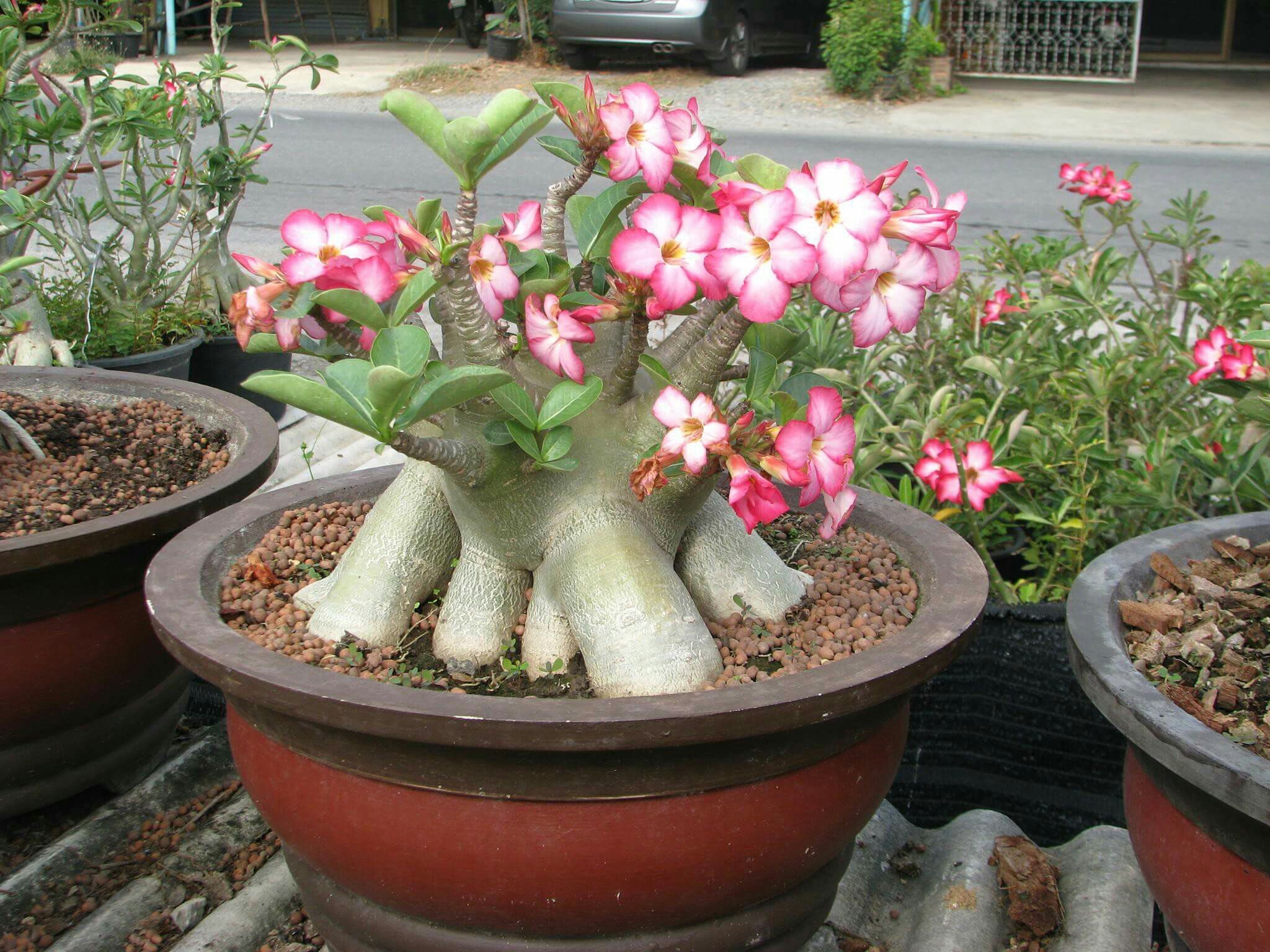
Boekhmanium
This species has an unexpressed caudex and thick branches that reach 3 m in nature. It is characterized by upward growth rather than breadth, and branching cannot be stimulated with pruning. Leaves with a grayish bloom, 15 cm in length, elongated, heart-shaped.
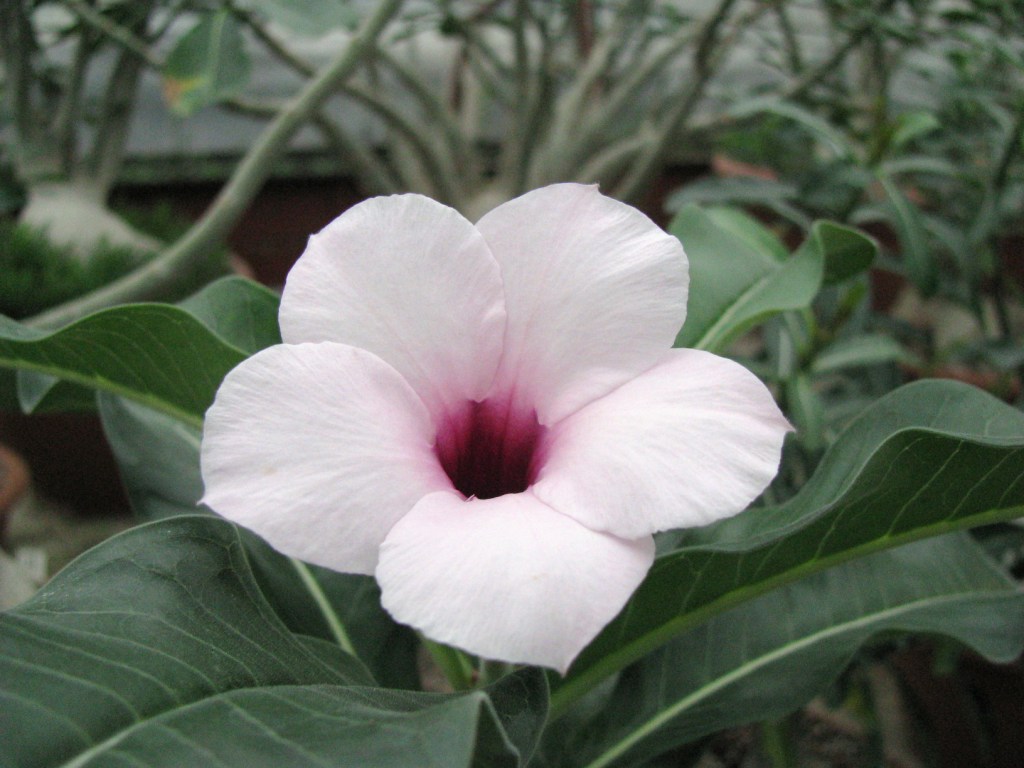
Flowers are round, pink. Appear at a fairly late age. The growing season is short - 3 months. Then you can observe a short flowering. At other times, the plant exists even without leaves.
Multiflorum, or multi-flowered
A well-branching shrub from southeast Africa becomes a tree only in very good conditions.Caudex is noticeable only at a young age. Over the years, it changes, branches grow from the underground rhizome.
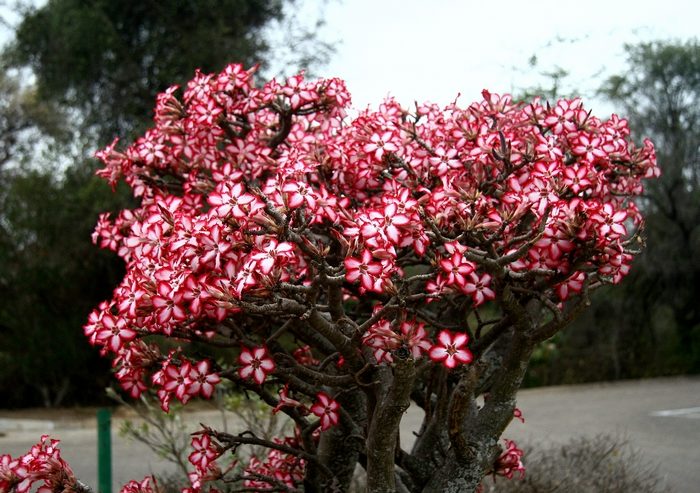
The maturity period, it is the flowering period, begins in 4-5 years. The name suggests that the plant blooms very profusely. Light petals with a bright border of red shades, flower size 5-7 cm. The leaves are wide, large. A multi-flowered adenium needs a 4-month dormant period with coolness and drought.
Obesum, or Fat
Fat Adenium is one of the most common varieties, thanks to a fairly early flowering (aged 1.5-2 years) and unpretentiousness to conditions. The habitat encircles the center of Africa. It has branches with sharp tops. Leaves are glossy, lanceolate, dark green. He does not always reset them, only if the winter is cool.
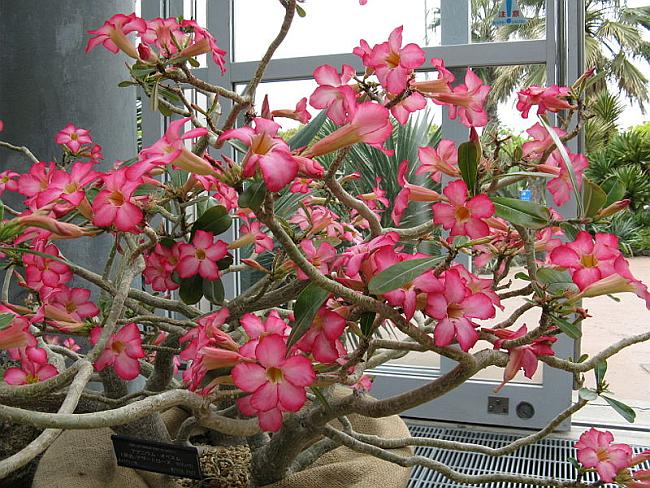
New foliage grows in the spring with the beginning of the growing season, but often the flowers appear earlier. Obesum blooms from spring to autumn, and in ideal conditions even year-round. The shapes of flowers are diverse: from simple to terry. Colors of all shades: from white to red.
Olefolium
This type of adenium has a second name - oil-leaved, is stunted (maximum 60 cm in height) and the slowest growing tree. In his homeland, he was content with stony, poor soils and a meager supply of moisture.
The thickening of the stem is formed only underground and reaches no more than 30 cm in diameter over many years. The leaves of the adenium are gray or olive, long and narrow, about 6-11 cm in length and 0.5-1 cm in width. The flowers are also small, up to 5 cm maximum, white and pink, often yellow in the center.
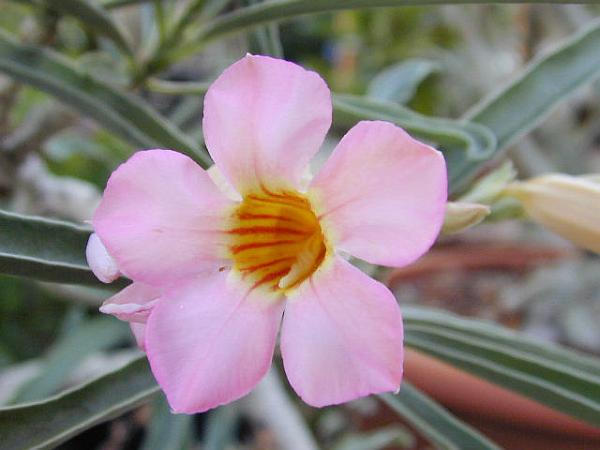
Oliefolium is interesting because locals make a cure for snake and scorpion bites from its juice, and sometimes, on the contrary, grease their arrows with it as an aid to hunting.
Swazikum
Caudex in this adenium is well developed, with age it is supplemented by pronounced branches and aerial roots. Its usual height is 30-35 cm, rarely up to 65 cm. The leaves are light, narrow and long, wrapped up at the edges from the abundance of the sun. Flowers are 6-7 cm in diameter, their color is pink and monophonic among natural representatives; after selection, shades appeared in the light and dark sides.
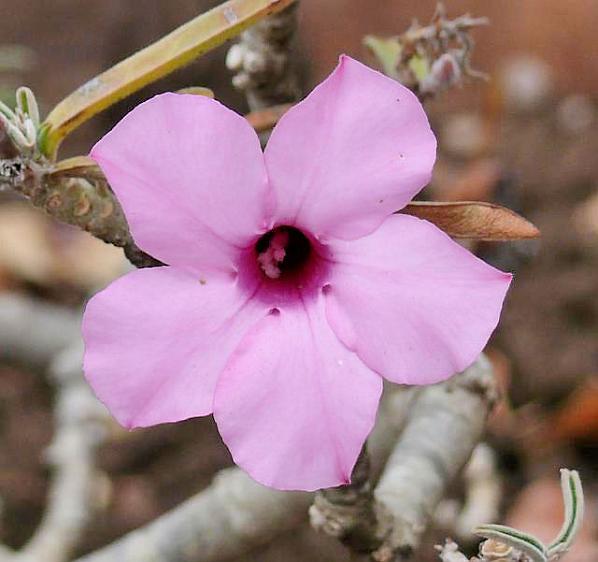
Hardy, withstands cold winters and even minimal frosts. At rest, the leaves fall off. At home, it is under state protection due to the threat of extinction.
Socotranum (Socotran)
This plant is a resident of the island of Socotra in the Indian Ocean. Outwardly, it is very similar to baobab. Hardy, growing on depleted soil among stones. Caudex is columnar, reaches a diameter of 2.5 m, and in height along with a small bush of branches - 4 m. Transverse stripes run along the entire surface of the trunk.
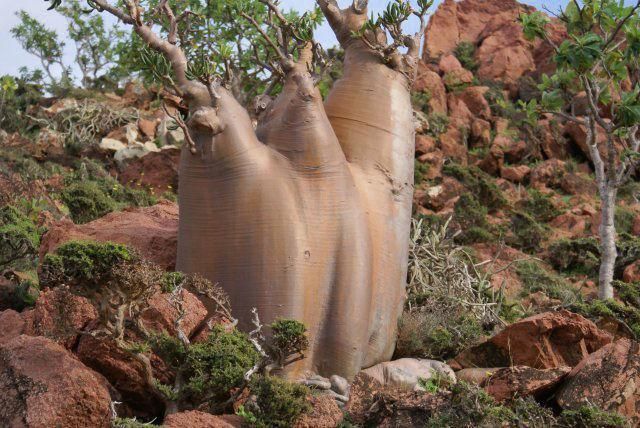
Leaves are green with white veins. For most of the year, adenium is at rest, leafless. It blooms at a late age in spring; by summer it is covered with leaves for several months. The flowers are pale pink with a brighter hue at the edges. Today, this species is protected by the state. Even its seeds are prohibited for export.
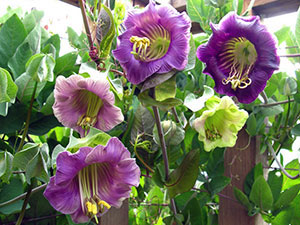 You may be interested in:
You may be interested in:Somalense (Somali)
The name of the plant also speaks of its origin. Depending on the terrain, the height of the trunk varies from 1.5 to 5 m, and the shape is from a shrub to a tree with a thickened caudex. It grows quickly, blooms profusely with expressive pink flowers up to 5 cm in diameter. Very sensitive to cooling.
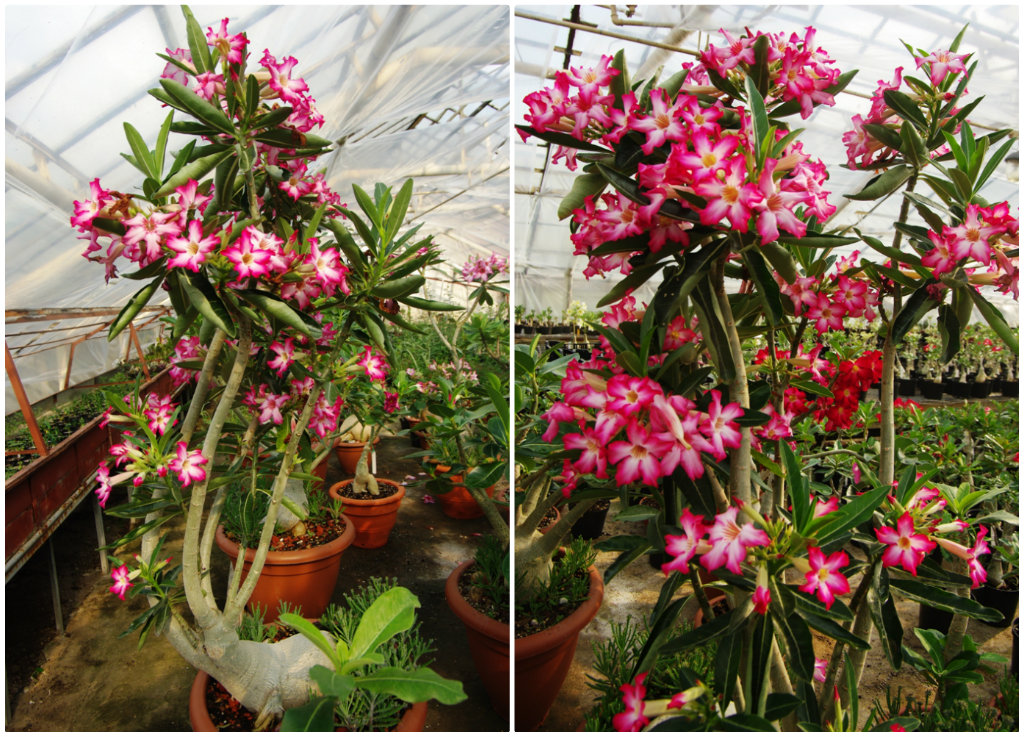
Variegated species
This group is not one species, it includes representatives of different varieties. Their variability is united - the presence of mutant cells in the leaves that are unable to produce chlorophyll. Therefore, the sheet has an uneven color, white spots and stripes on it.
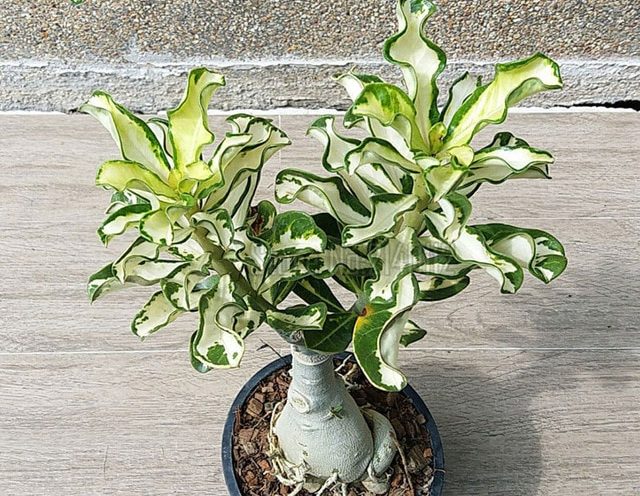
Such plants are less resistant to difficult climatic conditions, spotting can disappear when changing lighting, top dressing, temperature.
Miniature hybrids
Another generalized group of adeniums created by crosses of different species, resulting in dwarf plant sizes. These are mainly socotranums, arabicums, and obese. Interesting “wing” forms have been deduced, which are named for the similarity of twisted leaves with curly wool of sheep.
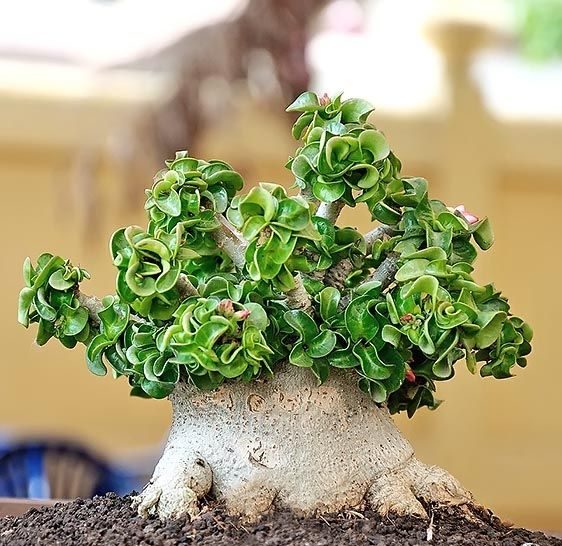
Adenium care at home
The popularity of adeniums has grown rapidly in recent years, and the secret of this is their undemanding, simple care, accessible to beginner gardeners without special skills.
Lighting
The photophilousness of adenium is explained by the place of origin, so the south side of the window is quite suitable for it. In summer, you can take out to balconies and terraces, where there will be more plentiful lighting. True, it is still worth shading from scorching rays, as trunk burns can form.
Temperature and humidity
Our summer temperatures in the range of 25-35 ° C are ideal for succulents, many species will not suffer from hotter conditions. In winter, it will be logical to reduce it, since the amount of light is reduced, and they are closely interconnected. It will be quite appropriate 10-15 ° C.
Interestingly, the reaction to the uncomfortable decrease and increase in temperature at the adenium is the same: it stops growing, and if these conditions do not change or worsen, then completely discards the foliage.
Also directly proportional to humidity and humidity. At high rates, it should also be high and vice versa: with cooling, there is a need for drier air, as this happens in nature.
Watering and feeding
In the summer, watering is carried out as the soil dries, and in winter, during dormancy, the frequency of soil moisture is reduced. Watering can be completely stopped if the right temperature is set in the habitat - no higher than 15 ° C.
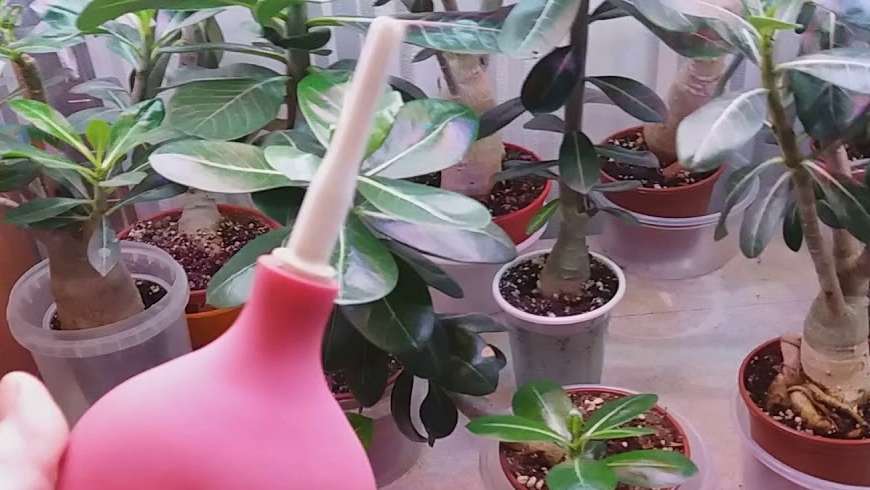
Adeniums are not spoiled by the nutritional value of soils in nature. But since in room conditions there is an opportunity to accelerate their growth, then during the growing season you can use fertilizers for cacti with a frequency of once a month.
Pruning and pinching
Adenium is a good object for artistic formation, for example, when creating a bonsai. They make it by trimming excess branches with a sharp tool (for quick and accurate movement, so that trauma to the plant is minimal), which must be wiped with a disinfectant after each cut.
Both procedures are performed at the beginning of the growing season, sometimes during all this time, but not during the dormant period. A day or two before pruning, the plant needs to be watered to provide good turgor to the tissues. Part of the branch is removed so that there is a kidney and a few millimeters of shoot above it.
Diseases, pests and methods of dealing with them
If insect pests get into the house along with a diseased plant or infected soil, then with a high probability a juicy adenium will become the object of their attention. This is a scabbard and aphids, sometimes with dry air a spider mite appears, and excessive watering will provoke the appearance of a mealybug. In addition to compulsory quarantine, pests should be collected manually or using sticky traps, and then treated with an insecticide.
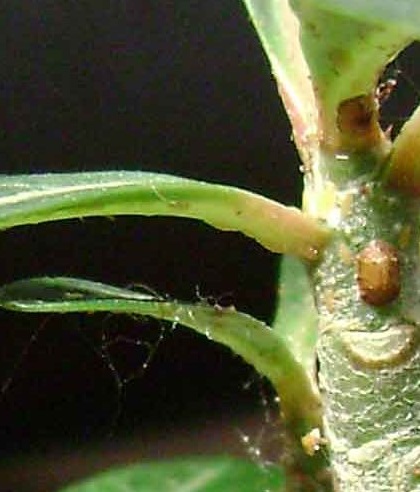
In nature, adeniums are affected by viral diseases.At home, this is also possible if the flower is grown from cuttings imported from Asia and America, where they were infected and are carriers of the virus. The plant does not die immediately, it degrades for several years, and changes outwardly. For the safety of other colors, it must be destroyed.
Transfer
Adenium needs transplants not on schedule, but when there are specific reasons. They can be like this:
- the flower came to you with poor-quality soil - it can be a transport or poorly selected soil mixture, dense and clay;
- disease associated with soil or roots - it is advisable to replace the affected soil with calcined fresh;
- a pot of the wrong size - it will be bad for the plant both in a cramped and too spacious container.
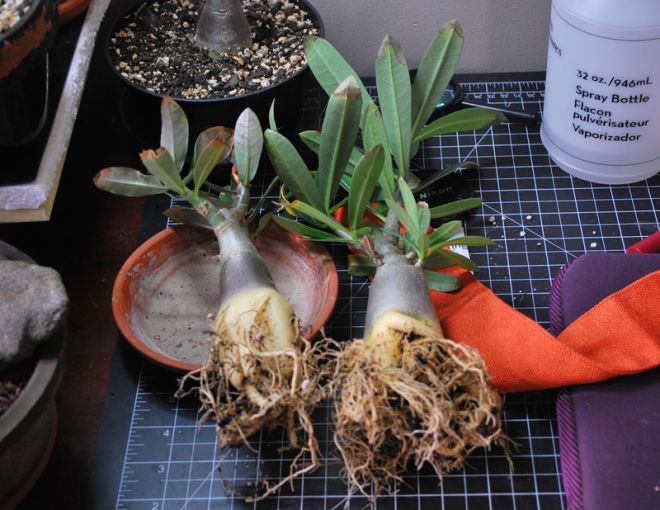
Loose soil is needed: a mixture of sand, peat, turf land with the addition of brick chips and charcoal. If this is not possible, then you can buy ready-made in the garden store marked "for cacti."
When transplanting a seedling, it is not necessary to clear it of soil, you need to transfer it from a smaller pot to a larger one along with an earthen lump and add fresh earth. With a large plant, you can do otherwise. Usually, with each subsequent planting, the roots are more and more exposed, lifting above the ground for decorative purposes. Therefore, they should be washed before boarding.
If the root is damaged during the manipulation, you need to sprinkle it with wood or activated charcoal so that the wound is dried. Adenium is watered before, and not after planting.
The technology of growing adenium from seeds
Propagation of adeniums from seeds at home has its drawbacks, for example, there will be no 100% guarantee that the mother variety will grow. But then the owner has the opportunity to form a caudex the way he wants, starting from a very early age of the plant.
Preparing planting material
At the beginning of the process, the seeds are processed. This rejects dead specimens, and the rest "wake up" for growth. Preparation looks like this:
- Soak for half an hour in a remedy for possible fungi. It can be any fungicide or potassium permanganate solution.
- Dilute the growth stimulator and hold the seeds in it for 2 hours.
- Collect and discard all pop-up seeds.
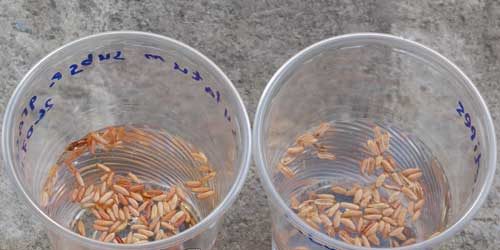
Seed preparation
Sometimes gardeners sprout seeds to get the result for sure. To do this, spread the seeds on a cotton pad or cloth, moisten and hold on the windowsill until they see a small spine. And sometimes they keep it even before the first leaves appear.
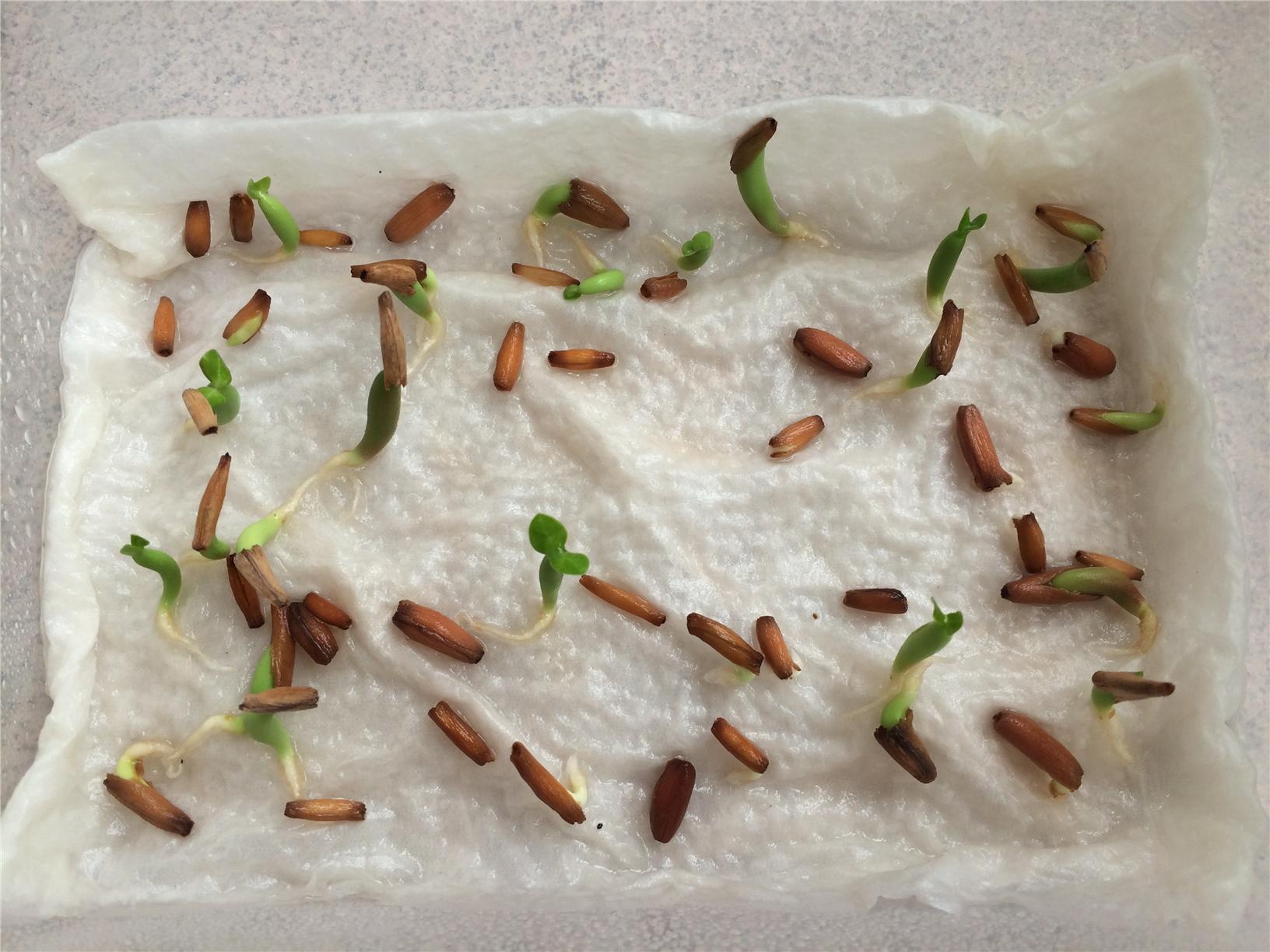
How to sow seeds
Soil for crops is taken the same as when transplanting an adult adenium, but with a large percentage of peat and sand - for looseness. Also perlite will not hurt. Next, you need an algorithm like this:
- spread the substrate into containers, and seeds horizontally from above;
- sprinkle them with a layer of 1 cm;
- moisten the top layer with a spray gun;
- cover the crops with a transparent lid or film, creating a greenhouse with a microclimate.
Crop care, transplanting
The containers should be kept warm - at 25-30 ° C and ventilated by removing the coating. After a maximum of 2 weeks, seedlings should appear. Then the film is removed and first diffused lighting is provided, and after the appearance of 2 sheets - complete, as for adult adenium.
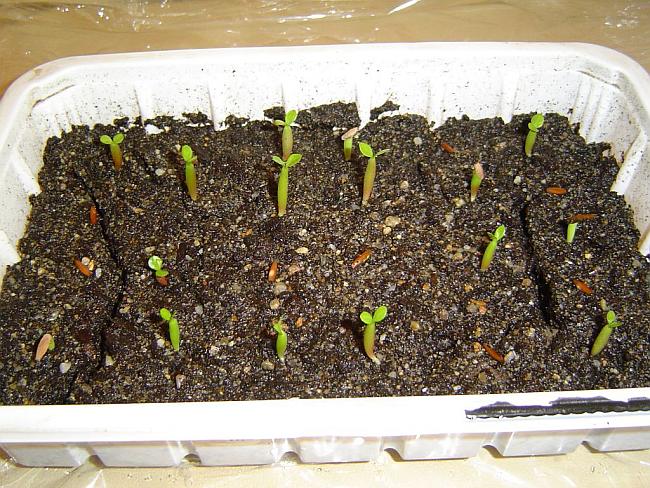
With the appearance of leaves and reaching the age of 1-2 months, adenium can be helped with mineral fertilizers, well diluted with water. In 3-4 months, seedlings can be transplanted by transhipment in larger containers, filling up to half with drainage, and from above with earth.
Most common mistakes
There is nothing superfluous in such a simple growing sequence.If you miss one of the proposed actions, you can lose the plants. For example, the rejection of culling of emergent seeds will increase the amount of unnecessary work, as part of the seedlings will not sprout. If not soaked in fungicide, then the fungus can destroy the tiny adenium in the first days of its life.
The same consequences can be without ventilation, excessive humidity will cause the development of mold. And even in the sprinkling of seeds has its own meaning: a small layer can not cope with the retention of the peel in the ground so that the sprout can be released from it. In this case, you will have to help with your hands and tweezers, the work is jewelry, there is a risk of damaging the plant.
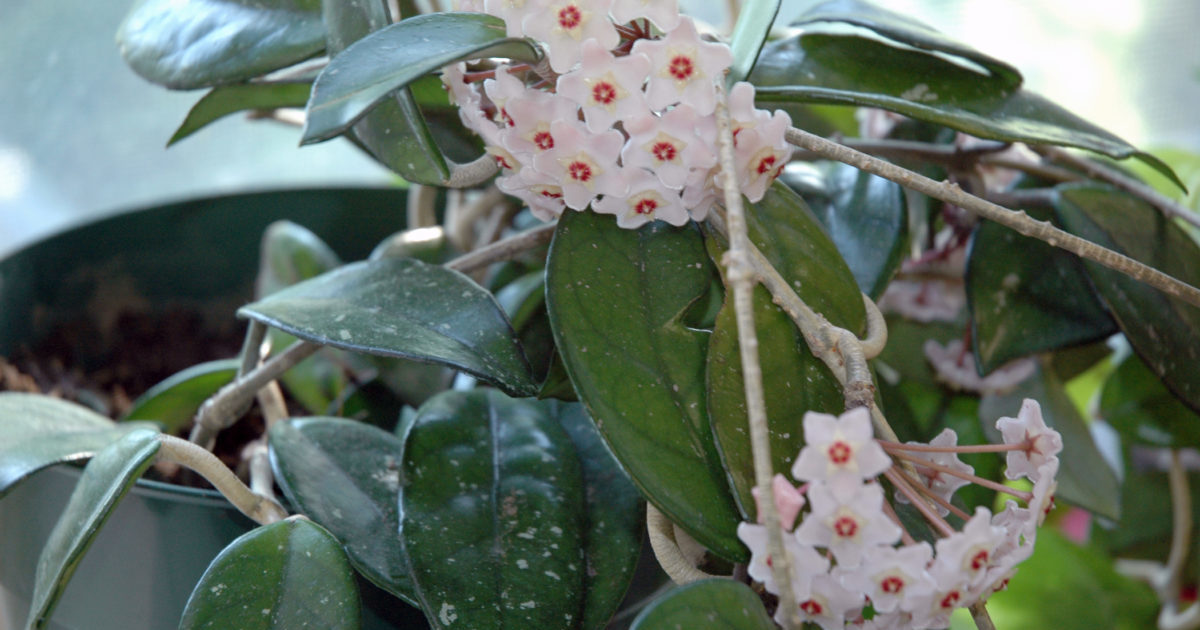 You may be interested in:
You may be interested in:Adenium Care Reviews
Often, it’s the reviews of real people that help determine the choice of a plant and its variety. Growing experience will help to avoid mistakes in care:
Anna M .: “My friends gave me. I didn’t really hope that it would take root, something my flowers did not last long. And this one has unexpectedly been alive for 2 years, and blooms, which is surprising. So, in gratitude to him, I re-read everything on leaving, and the truth turned out to be not whimsical. ”
Vadim S .: “After an excursion to the conservatory greenhouses, I caught fire to grow, ordered seeds, having studied the matter thoroughly. Now I have six-month-old seedlings, not a single one has died, they grow and delight the whole family. It is interesting that even such babies in shape as adults, the trunk with a thick column. "
Olga R .: “And I have a very wet apartment, ground floor, northern windows. I presumptuously bought an adenium, and it is still alive, but it looks bad, it seems that it is sick. I don’t know, I checked the soil, I follow the watering, but apparently the humidity and high-quality lighting are more important for him. ”
Common Growing Questions
Adenium is an unusual exotic plant, which is characterized by unpretentiousness in care. It attracts attention with bright colors and an unusual shape of the trunk, which can accumulate water. Suitable for cultivation by both experienced and beginner growers.

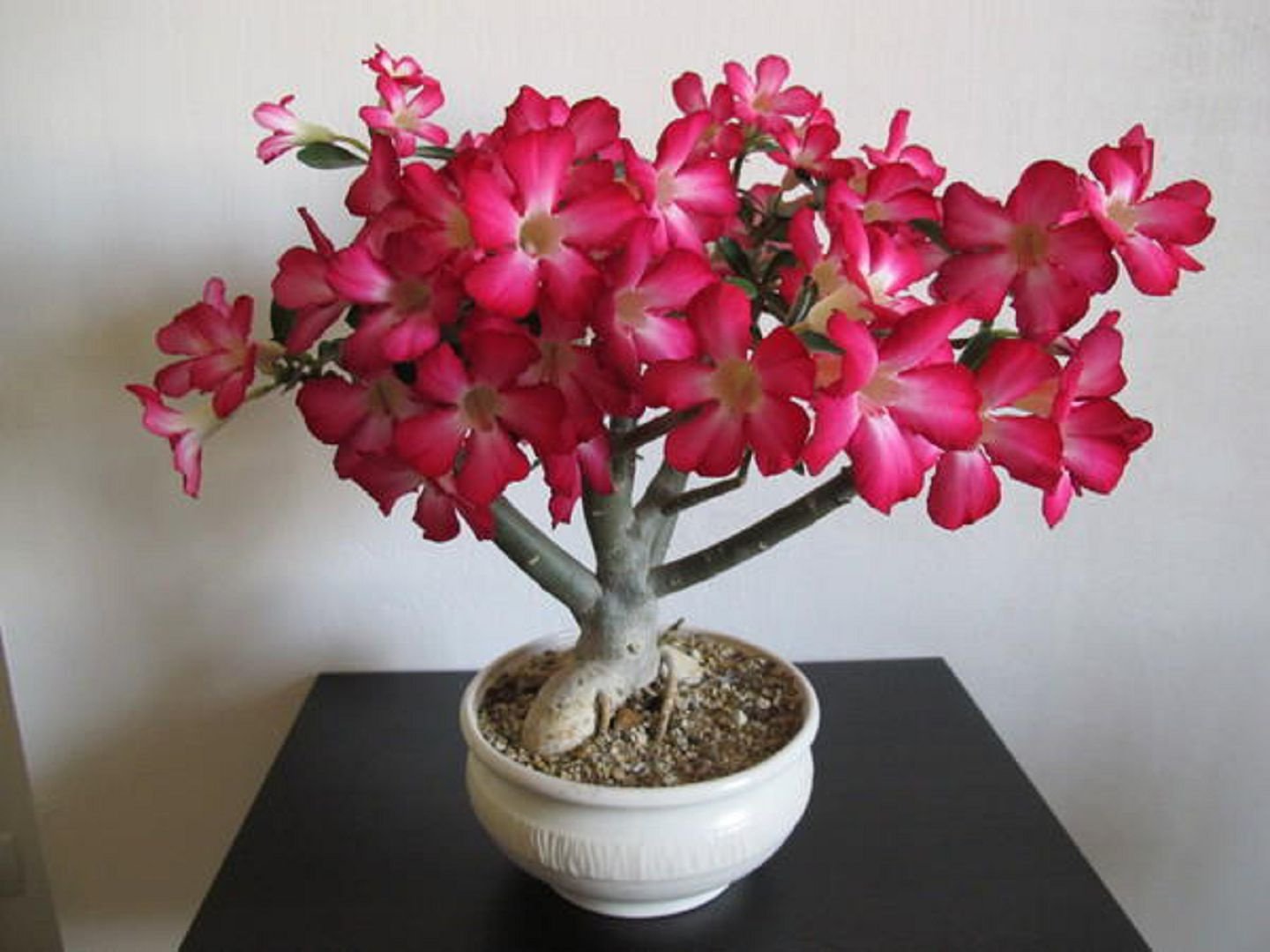
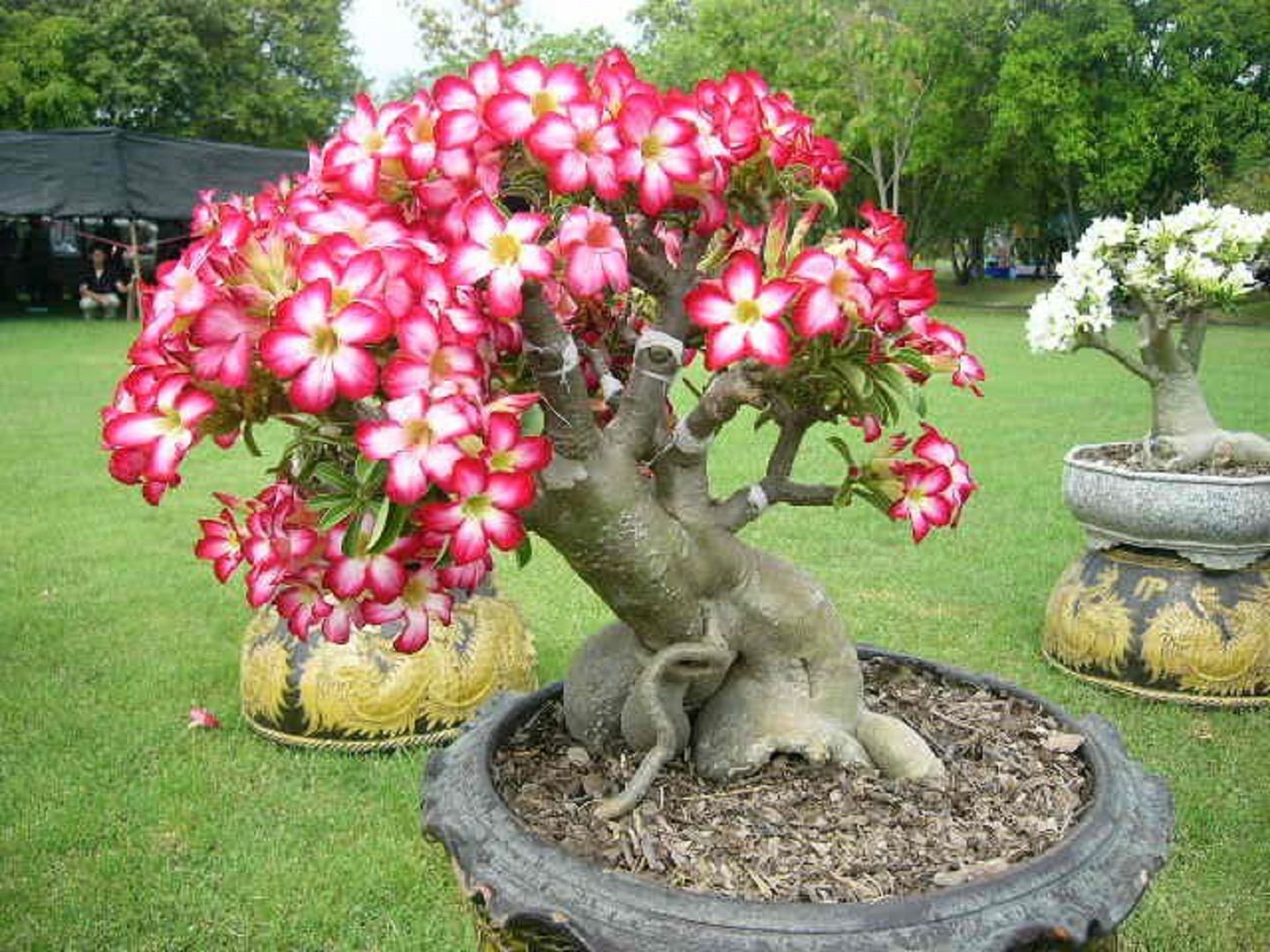
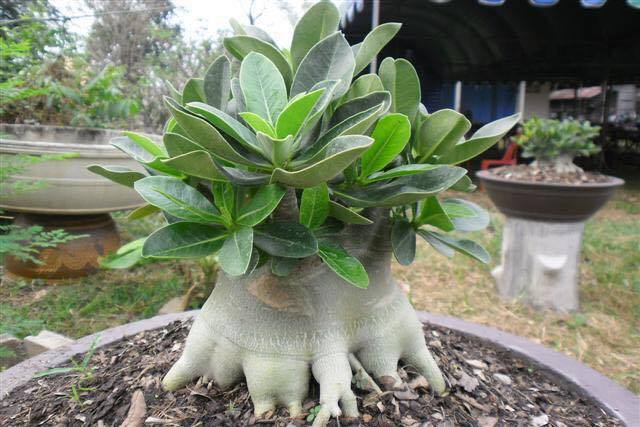



 10 beautiful annuals that bloom all summer
10 beautiful annuals that bloom all summer Sow in the ground, without seedlings: 10 beautiful and unpretentious flowers
Sow in the ground, without seedlings: 10 beautiful and unpretentious flowers Platicodon planting and outdoor care
Platicodon planting and outdoor care Hosta - planting and care in the open ground in the Urals
Hosta - planting and care in the open ground in the Urals